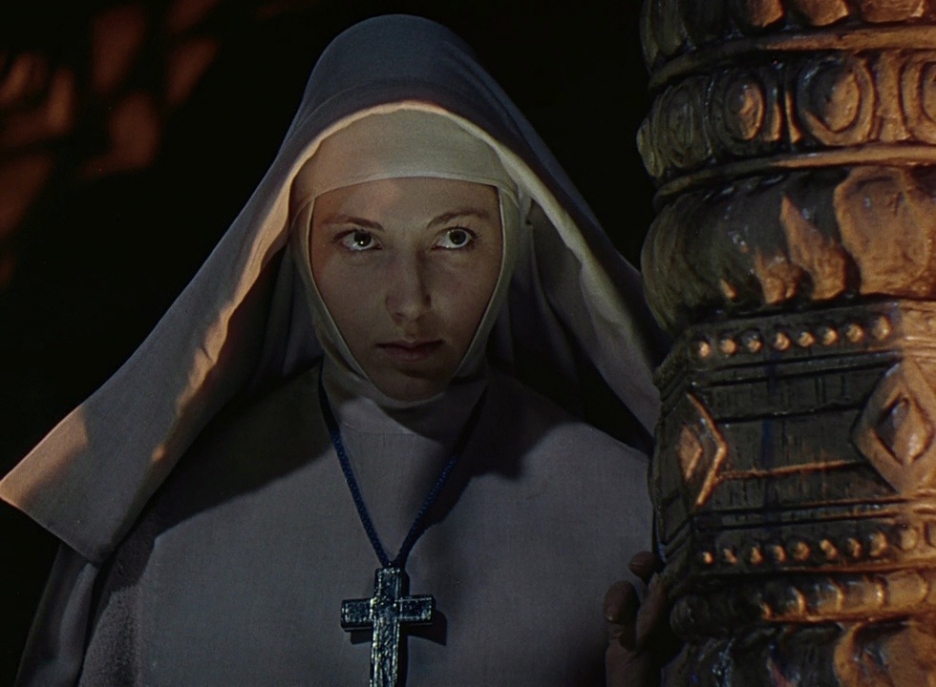 |
| Fig 1: Black Narcissus |
Black Narcissus is a film which relishes in the idea of a viewer doing some of the work for themselves, only the most shrewd observer would notice some of the more theme enhancing aesthetics. It is true that in many shots the nuns longing for freedom could be interpreted, as we see members of the nunnery ringing the large bell on the cliff edge wishfully, the mind strays to images of confinement and pain. However this could also been seen as a way of presenting the nuns longing for a male companion as the bell represents a certain aspect of male genitalia, Peter Bradshaw describes the area the are living in as being "complete with erotic frescos" (Bradshaw, 2005). Another big slice of symbolism which is present from the very birth of the film is the idea of the nuns constantly being on the edge, possibly showing how the nuns are pushed to their limits whilst following their practises, as they spend the majority of the film literally inhabiting a palace on the very edge of a mountain.
 |
| Fig 2: Black Narcissus |
It is also interesting to note that the members of the nunnery that are chosen to go to work in the secluded palace are chosen because of different aspects of their personality, one for her strength, one for her popularity, one for her gardening abilities, one to be the leader and one because she is ill. This could possibly be interpreted as a way of showing how no member of the nunnery is fully capable of success without another's help, possibly showing the negative effects of relying so strongly on God and how it is starting to chip away at their lives. This idea of the nuns struggle being present throughout the film has also been thought by others, with Roger Ebert stating that "Their inner turmoil is exacerbated by extreme conditions and isolation" (Ebert, 2010). This only supports the idea of the palace itself as being a cocoon for the nuns to shed their faith and develop doubt.
 |
| Fig 3: Black Narcissus |
Another interesting point to think about after viewing Black Narcissus is that even after the nuns reliance on God has shown to cause members of the nunnery to crumble and in one case even attempt murder, the film itself still closes showing religion in a positive light. As the remaining members of the nunnery leave the palace in the mountains, clouds cover the screen blocking the palace from view and leading the viewer with a negative opinion on the effects the palace has had on the inhabiting characters, rather than their religious lifestyle choices. This is interesting as it forces the audience to see the palace the nuns are working in as the villain of the film, turning nuns from their faith, when another angle to view this from could be that the palace actually frees the nuns from the shackles of their faith.
Black Narcissus is truly a film to be watched with intent to find symbols, metaphors and trailing endless theories, as shots lend themselves to being interpreted differently by different kinds of viewers. The film itself has been described as "a work of rare pictorial beauty" (Pryor, 1947) which seems a very fitting way to describe the surroundings and a number of shots throughout this tale of hysterical nuns. This film has without a doubt left viewers to ponder over its intentions and the messages that run throughout for many years, and there is no doubt that it will continue to do so for many years to come.
Bibliography
Bradshaw, Peter, 2005, Black Narcissus, http://www.theguardian.com/theguardian/2005/aug/05/3 Accessed on 10/11/15
Ebert, Roger, 2010, "Black Narcissus, Which Electrified Scorsese,
Accessed on 10/11/15
Pryor, Thomas, M, 1947, Black Narcissus, http://www.nytimes.com/movie/review?res=EE05E7DF173CE261BC4C52DFBE66838C659EDE Accessed on 10/11/15
Illustration List
Fig 1: Poster, Black Narcissus, http://m.flicks.co.nz/movie/black-narcissus/poster/ Accessed on 10/11/15
Fig 2: Screenshot, Black Narcissus, http://thefilmexperience.net/blog/2013/7/9/top-ten-1940s.html Accessed on 10/11/15
Fig 3: Screenshot, Black Narcissus, https://www.criterion.com/films/632-black-narcissus Accessed on 10/11/15

'If a cinema lover had to choose their favourite dark film concerning hysterical nuns, there is no doubt this would make the cut.' Hehehehe! I know it is top of my list of hysterical nun films :)
ReplyDeleteDon't forget to italicise your film names and quotes, Lewis. Also, it might have been good to explore the production design a little more - the use of the matte painting to extend the scene, for example.
Other than that, a very enjoyable read! :D